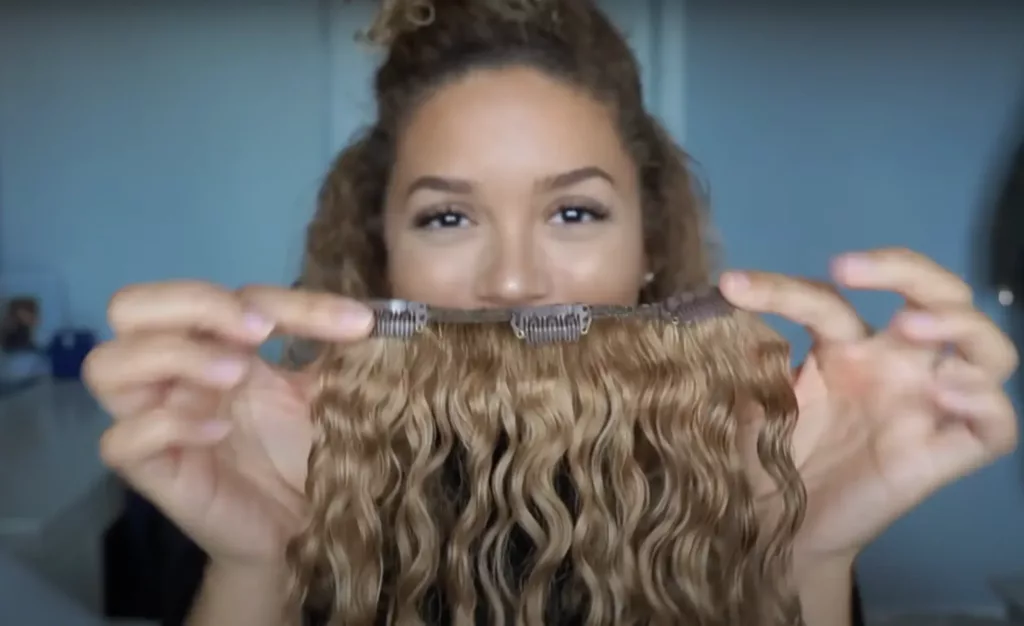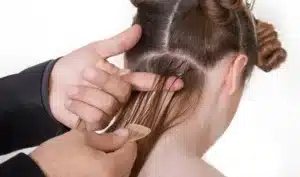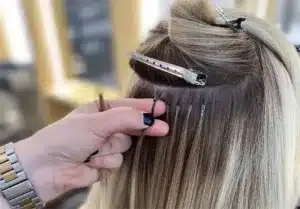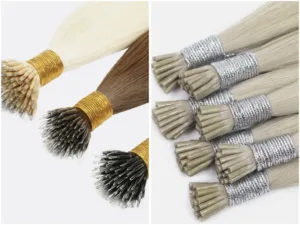Frizz, tangles, and flat curls can ruin great hair in minutes. Washing is the turning point. Do it right, and curls bounce back soft and defined.
Wash curly hair extensions with gentle products, careful detangling, cool-to-lukewarm water, and low friction. Clean the scalp area (if installed), hydrate the lengths, blot dry, and set curls with leave-in and gel or cream. Avoid heat on bonds and stitching.

Before water touches the hair, set a plan. Gather the right tools. Work in sections. Respect the curl pattern. The steps below keep cuticles smooth, curls springy, and installations secure—whether the curls are clip-ins, wefts, tape-ins, or keratin bonds.
What are Curly Hair Extensions?
Curly textures vary by curl size, origin, and processing. Not all curls need the same wash routine. Knowing the type prevents frizz and loss of pattern.
Curly hair extensions are human-hair pieces formed into waves, curls, or coils by steam-setting or by preserving the donor’s natural curl. They come as clip-ins, wefts, tape-ins, and keratin bonds, each with different wash limits.
Dive deeper
Curly extensions fall into two broad families: naturally curly donor hair and steam-set textures. Natural donor curls behave like a person’s own curls. They respond well to water, slip, and light gels. Steam-set textures are shaped with heat and steam while the cuticle is intact. They hold pattern well but can relax if exposed to high heat, strong alkaline products, or aggressive brushing. Understanding that difference guides product choice and heat rules.
Construction also matters:
- Clip-ins have metal clips sewn to a fabric track. They are removable, so washing off the head is common.
- Wefts (genius or hand-tied) are sewn or beaded to rows. The stitch line should not be soaked in heavy oils.
- Tape-ins use PU adhesive. Oils and heat near the tape can cause slip.
- Keratin (U-tip/I-tip) bonds require strict heat control; no scrubbing at bonds.

Curl patterns range from 2A waves to 4C coils. Tighter patterns need more water, more slip, and less disturbance. Looser patterns tolerate light brushing when wet. Choose a technique that protects the pattern, then add moisture with conditioners and masks that do not collapse volume.
| Attribute | Natural donor curl | Steam-set curl |
|---|---|---|
| Pattern memory | Strong, elastic | Strong but heat sensitive |
| Product tolerance | Likes water + light gel | Avoid heavy oils at base |
| Heat tolerance | Moderate | Lower near set pattern |
| Best tools | Wide comb + fingers | Fingers + wide comb only |
How to Wash Curly Hair Extensions?
Curly hair loves water and slip. It hates friction and heat at the base. A simple, repeatable method wins every time.
Detangle in sections, cleanse with sulfate-free shampoo at the scalp area, condition mid-lengths to ends, and rinse cool. Blot, apply leave-in plus curl cream or gel, then set curls. Keep heat and oils away from bonds and stitches.
Dive deeper
Set up the station. You need a sulfate-free shampoo, a hydrating conditioner, a slip-rich leave-in, and a curl cream or gel with medium hold. Add a wide-tooth comb, a microfiber towel, and section clips.
1) Section and detangle.
Create 3–4 sections. Support the base with one hand. Start detangling at the ends, then move upward with a wide comb or fingers. Add a small amount of leave-in for slip. Do not rush this step.
2) Cleanse the scalp and base.
If installed, focus shampoo at the scalp and between rows. Use the pads of your fingers. Keep motions vertical. Avoid rough circles. Let suds run down the lengths without scrubbing curls. For clip-ins off the head, hold the track and smooth shampoo downward through the curl with minimal agitation.
3) Condition and hydrate.
Squeeze excess water, then apply conditioner from mid-lengths to ends. Use praying-hands motions. Finger-comb to distribute. For very dry curls, layer a mask once a week. Keep conditioner off tapes and bonds.
4) Rinse and cool-set.
Rinse with cool water to close cuticles. Do not over-rinse. Leave a touch of slip for definition.
5) Blot and define.
Blot with a microfiber towel. Do not rub. Apply leave-in for moisture, then scrunch in curl cream or gel. Use small amounts. Add more only if needed.
6) Dry smart.
Air-dry when possible. If diffusing, use low heat and low airflow. Keep heat away from tapes and keratin bonds. For wefts, ensure the stitch line is fully dry to prevent odor.
| Step | Tool | Key rule | Risk if ignored |
|---|---|---|---|
| Detangle | Wide comb | Ends → roots, support base | Breakage, frizz |
| Cleanse | Fingers | Scalp focus, vertical motion | Slip, tangles |
| Condition | Hands | Mid→ends only | Bond failure |
| Rinse | Cool water | Leave slight slip | Dry, dull curls |
| Define | Microfiber | Blot, never rub | Frizz halo |
| Dry | Air/diffuse low | Keep heat off bonds | Lifted tapes/keratin |
Which products work best for curly extensions?
Too heavy, and curls collapse. Too light, and frizz wins. Product weight must match curl pattern and installation type.
Use sulfate-free shampoos, silicone-light or water-soluble conditioners, slip-rich leave-ins, and medium-hold curl creams or gels. Keep oils and butters off the base. Prefer heat protectant mists if using tools.

Dive deeper
Shampoo: Pick pH-balanced, sulfate-free formulas that clean without stripping. Look for gentle surfactants and light hydration. Avoid clarifiers at every wash; keep them for build-up once every 3–4 weeks.
Conditioner: Choose conditioners with water-soluble silicones or light esters. They smooth cuticles without heavy residue. Apply from mid-lengths to ends. For tight coils, a richer mask once weekly helps elasticity.
Leave-in: Slip matters more than oil content. A good leave-in helps detangling and reduces friction during styling. Spray or milk textures prevent build-up.
Stylers: Use a curl cream for moisture and shape, then seal with a light gel for hold. Gels with PVP/VP copolymers or similar film-formers hold curl without crunch when used sparingly.
Avoid: Heavy oils, pure butters, and waxes at the base. Alcohol-heavy sprays that dry fibers. Sunscreens with avobenzone on hair can cause staining on light colors; choose hair-safe UV sprays or cover hair when applying skin SPF.
| Category | Choose | Avoid |
|---|---|---|
| Shampoo | Sulfate-free, pH 4.5–5.5 | Daily clarifiers |
| Conditioner | Water-soluble slip | Heavy butters at base |
| Leave-in | Light milk/spray | Oil near bonds |
| Styler | Cream + light gel | Hard wax pomades |
| Heat protectant | Fine mist | Oily serums at base |
How often should curly extensions be washed?
Too frequent washing dries curls. Too little washing builds residue and dulls shine. Balance is key.
Wash every 5–10 days for installed curls, based on lifestyle and scalp needs. Clip-ins can be washed after 4–8 wears. Co-wash between shampoos if the scalp is stable and bonds allow it.
Dive deeper
Activity level drives cadence. Athletes, hot climates, and frequent styling push toward five to seven days. Desk jobs and cool climates stretch to seven to ten days. Watch signals instead of the calendar: scalp itch, dull cast, heavy feel, or less curl spring means it is time.
Installed systems add limits. Tape-ins and keratin bonds do not like frequent soaking or product at the base. Space wash days. Keep dry shampoo off the bonds. For wefts, cleansing at the scalp with gentle pressure keeps rows fresh. Clip-ins off the head can go longer because they do not touch sebum daily; they need a wash when product builds up or curls look flat.
Add a monthly reset: one gentle chelating wash if water is hard or if styling products build. Follow with a deep mask and a cool rinse. Always check bonds and stitch lines after any reset.
| Lifestyle | Frequency | Notes |
|---|---|---|
| Gym 4–6×/week | 5–7 days | Rinse sweat, air-dry base |
| Office, mild climate | 7–10 days | Refresh with spray leave-in |
| Clip-ins only | 4–8 wears | Wash off-head, air-dry |
| Hard water area | Monthly chelate | Mask after chelate |
How do methods differ by installation type?
Each system sets its own limits. The base decides the rules.
For clip-ins, wash off the head. For wefts, keep the stitch line clean and dry fast. For tape-ins, avoid oils and heat at the tape. For keratin bonds, no scrubbing at bonds and no high heat near tips.
Dive deeper
Clip-ins: Remove all pieces. Close clips. Hold the fabric track and let water run in the direction of the curl. Clean with downward motions only. Condition mid-lengths to ends. Blot and air-dry flat on a towel. Define curls with cream and a small amount of gel. Never store damp.
Wefts (genius/hand-tied): Support rows during detangling. Shampoo the scalp with vertical motions between rows. Let foam glide over the lengths. Condition from mid to ends. Rinse cool. Towel blot at the stitch line and lengths. Dry the stitch fully to avoid odor. Diffuse on low if needed, holding the dryer away from the stitch.

Tape-ins: Keep conditioner and oil off the PU strip. Shampoo gently at the scalp, never scratching across the tapes. Rinse thoroughly. Blot along tapes with a towel. Air-dry the base before adding leave-in to the ends. Avoid high heat; keep tools several inches away from tapes.
Keratin bonds: Do not rub bonds. Cleanse with palms, moving downward. Separate bonds with fingers while rinsing to prevent clumping. Condition below the bonds only. Dry bonds first with low heat and distance. Style lengths after the base is dry.
| Type | Key do | Key don’t |
|---|---|---|
| Clip-ins | Wash off-head, close clips | Twist fabric, store damp |
| Wefts | Dry stitch fully | Heavy oils at stitch |
| Tape-ins | Keep base product-free | Heat on tapes |
| Keratin | Separate bonds when rinsing | Scrub or bend bonds |
How do you dry and define curls after washing?
Drying makes or breaks the result. Curls set in the shape they dry in.
Blot, apply leave-in, then layer a curl cream with light gel. Scrunch upward, then hands-off while drying. Air-dry when possible. If diffusing, use low heat and low airflow, and avoid base areas.
Dive deeper
Start with a microfiber towel or a soft cotton T-shirt. Blot water without rubbing to avoid frizz. Apply a leave-in for slip. Then use praying-hands motions to apply curl cream from mid-lengths to ends. Scrunch in a small amount of gel to lock the pattern. The gel cast protects curls during drying.
Air-drying gives the softest finish and the longest wear. If time is short, diffuse with a bowl attachment at low heat and low airflow. Lift sections into the bowl and hold for a few seconds. Move around the head. Keep the dryer away from tapes and bonds. Once dry, “break the cast” with a tiny amount of serum on the palms, focusing on the ends, not the base.
If roots look flat, clip small root sections with metal duckbill clips while drying. Remove clips when fully dry. Do not touch curls during drying. Touch reintroduces frizz.
| Action | Why | Tip |
|---|---|---|
| Blot | Reduce frizz, keep pattern | No rubbing |
| Layer cream + gel | Moisture + hold | Use small amounts |
| Diffuse low | Protect bonds and pattern | Keep distance |
| Break cast | Soft, shiny finish | Serum only on ends |
How do you prevent frizz, matting, and shedding?
Friction and dryness cause most problems. Water, slip, and low-stress handling solve them.
Use slip during detangling, hydrate often, avoid rough towels and cotton pillowcases, and protect curls at night. Support the base when brushing. Schedule maintenance on time to prevent traction and tangles at the roots.
Dive deeper
Frizz starts when cuticles lift. Matting starts when small knots stack. Shedding increases when fibers stretch and snap under stress. The fix is simple: reduce friction, keep moisture balanced, and stop hard pulling at the base.
- Detangle only on wet or very damp hair with slip.
- Use a loop brush or fingers near the base; wide comb on the lengths.
- Replace rough towels with microfiber.
- Sleep with a silk or satin pillowcase and a loose pineapple or braid.
- Refresh between washes with a water + leave-in mix.
- Seal ends with a pea-size amount of cream if air is very dry.
- Keep heavy oils off bases and stitches to avoid slip and build-up.
If matting appears, do not rip through it. Saturate with water and leave-in. Work from the ends upward with small, steady strokes. For installed wefts, separate rows gently with fingers before combing lengths.
| Problem | Prevent | Fix |
|---|---|---|
| Frizz | Blot, leave-in, gel | Re-wet + scrunch with product |
| Matting | Sectioned detangling | Saturate + ends-up comb |
| Shedding | Support base, avoid yanking | Slow, small strokes only |
| Root tangles | On-time maintenance | Row separation with fingers |
My opinion
We suggest customers treat curls like fabric that holds a shape. Water sets the shape. Products keep that shape. Friction breaks it. A calm routine wins: section, add slip, clean the scalp, feed the lengths, then set and dry with patience. Small choices—cool water, microfiber towels, low airflow—protect both the curl pattern and the installation.

FAQ
What temperature should the water be?
Use cool to lukewarm water. Hot water lifts cuticles and can relax steam-set patterns.
How often should I wash curly extensions?
Every 5–10 days for installed hair, depending on activity and climate. Clip-ins after 4–8 wears.
Which shampoo is best?
A sulfate-free, pH-balanced formula. Save clarifying or chelating shampoos for monthly resets or heavy build-up.
Do I need both curl cream and gel?
Cream adds moisture and shape. Gel locks the pattern. Together they reduce frizz and hold definition.
How do I dry fast without frizz?
Blot with microfiber, diffuse on low heat and airflow, and avoid touching curls until 100% dry.
Is oil good for curly extensions?
Use tiny amounts only on the ends. Keep oils away from tapes, bonds, and stitches.
How do I fix crunchy curls?
Once fully dry, scrunch out the gel cast with a drop of serum on palms. Do not add heavy oils.
What if curls look stretched after washing?
Use more water and scrunch upward. Add a small amount of gel. Diffuse with bowl support to lift curls.
Can I brush curly extensions?
Brush only when wet with slip, or finger-detangle on damp hair. Avoid dry brushing.
How do I handle hard water?
Use a monthly chelating wash. Follow with a deep mask and cool rinse to restore slip and shine.
Are purple shampoos safe on curly extensions?
Use sparingly on mid-to-ends for toning blondes. Follow with hydration. Keep away from bases and bonds.
What causes odor after washing?
A damp stitch or tape. Dry the base completely. Use low heat and airflow focused on the base.
Can I swim with curly extensions?
Rinse with fresh water first, use a swim cap if possible, and wash soon after. Salt and chlorine dry curls and can weaken bonds.
Conclusion
Wash curls with low friction, balanced moisture, and smart drying. Clean the scalp, feed the lengths, then set and leave curls alone while they dry. Gentle steps protect pattern and installation.




